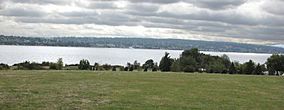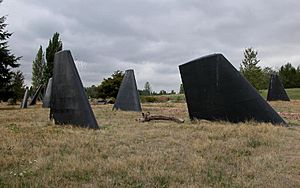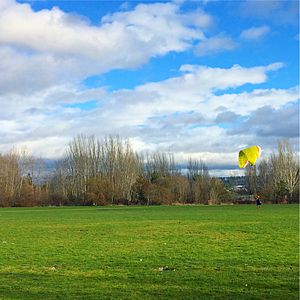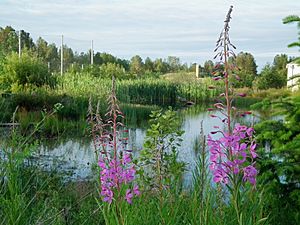Magnuson Park facts for kids
Quick facts for kids Magnuson Park |
|
|---|---|
| Warren G. Magnuson Park | |

Magnuson Park and Lake Washington in 2004
|
|
| Lua error in Module:Location_map at line 420: attempt to index field 'wikibase' (a nil value). | |
| Type | Urban park |
| Location | Seattle, Washington, U.S. |
| Area | 350 acres (1.4 km2) |
| Created | 1900 (military use 1922-1975) |
| Operated by | City of Seattle |
| Status | Open year round |
| Website | Official website: http://www.seattle.gov/parks/magnuson/ |
Magnuson Park is a large park in the Sand Point area of Seattle, Washington, USA. It covers about 350 acres (140 ha), making it the second-biggest park in Seattle. Only Discovery Park is larger. Magnuson Park sits on the Sand Point peninsula, which sticks out into Lake Washington in northeast Seattle.
Contents
Park History
Ancient Times
People have lived in this area for a very long time. They arrived after the last Ice Age, about 8,000 BCE. The Xacuabš people, who are now part of the Duwamish tribe, had a village called TLEHLS here. It was located near what is now called Wolf Bay. They also kept open grassy areas, like small prairies, in the region.
In 1900, the first park was created here. It was called Carkeek Park. After World War I, people wanted to build a Naval Air Station (NAS) at Sand Point. The U.S. Navy started building on the land in 1922. By 1926, the Navy owned the 413-acre (1.67 km2) site. The park was then moved and renamed Carkeek Park somewhere else. The area became known as Naval Air Station Sand Point.
The Naval Air Station Seattle closed down in 1970. The airfield was no longer used. Discussions then began about what would happen to the land.
Becoming a City Park
In 1975, a large part of the Navy's land was given to the City of Seattle. It was also given to the National Oceanic and Atmospheric Administration (NOAA). The city turned its land into a park and called it Sand Point Park. In 1977, the park was renamed Magnuson Park. This was to honor Warren Magnuson, a former naval officer and U.S. Senator from Seattle. Today, people still use both names for the park. The old airfield runways were removed in the late 1970s.
Park Features
Magnuson Park has many fun things to do. You can find sports fields, picnic spots, and a swimming beach. There are also places for public sailboating. Many paths are great for walking and biking. The park also has a special area for dogs to run off-leash. "Kite Hill" is a big grassy hill made from pieces of the old airfield. You can also launch boats from the park.

Sports Fields
The Sports Meadow is a 12 acres (4.9 ha) area with natural grass fields. It was built in the early 1980s on the old runway. In 2004-2005, it was rebuilt and raised to help with drainage. Now, it has four soccer fields.
More sports fields were added in 2009. Three of these fields have artificial turf and lights. They are mainly used for rugby and soccer. Later, a baseball field and a softball field were finished. These fields opened in late 2010. Water from the sports fields helps feed the wetlands area.
Amazing Wetlands
Sand Point is a great place for birds. It has the second-highest number of bird species of any park in Seattle. About 170 different kinds of birds have been seen here. This includes pine siskins, Anna's hummingbirds, and black-capped chickadees. The park's wildlife has improved a lot because of a wetlands restoration project. This project changed the park's landscape and how water flows.
When the naval air station was built, many natural marshlands were covered up. Water from rain and runoff used to go into storm drains. But as these drains got old, they didn't work as well. This caused water to pool up and made the sports fields too wet. Also, a lot of untreated water was flowing into Lake Washington.
The Wetlands Restoration project created new hills, flat areas, valleys, and ponds. These help guide the water better and drain wet areas. This new constructed wetland acts like a natural filter for urban runoff water. This helps reduce pollution in Lake Washington.
Part of this project involved removing an old parking lot and a large building. The building was once a hangar for aircraft. It was taken down in 2006. About 30 acres (12 ha) of wetlands were completed in 2009. They include walking paths and places to watch nature. The next part of the wetland restoration was finished in late 2011.
Fun Playground
Magnuson Park is home to Seattle's biggest playground. It's called the Junior League of Seattle Children's Playground. This playground was designed, built, and paid for by the Junior League of Seattle. This group is made up of women who volunteer and lead community projects.
The playground opened in 1999. It celebrated its 10th anniversary in 2009. Kids can play in the 20,000 square feet (1,900 m2) area. It has colorful climbing walls, a sand box, swings, and slides. The Junior League of Seattle gave this "Air, Land and Sea" themed playground to the children of Seattle. It was to celebrate their 75 years of helping the community. Children helped design the playground. Volunteers built it entirely on the site of the old Naval Air Station Control Tower.



